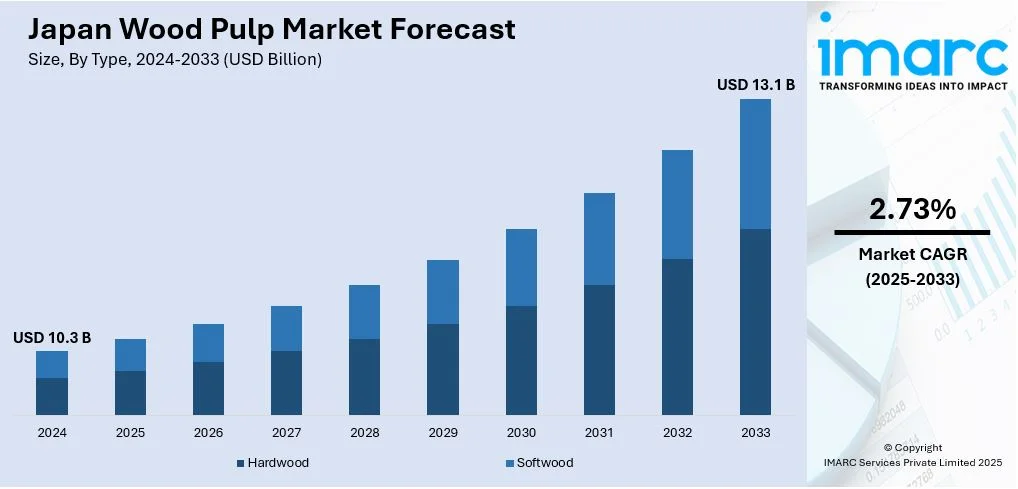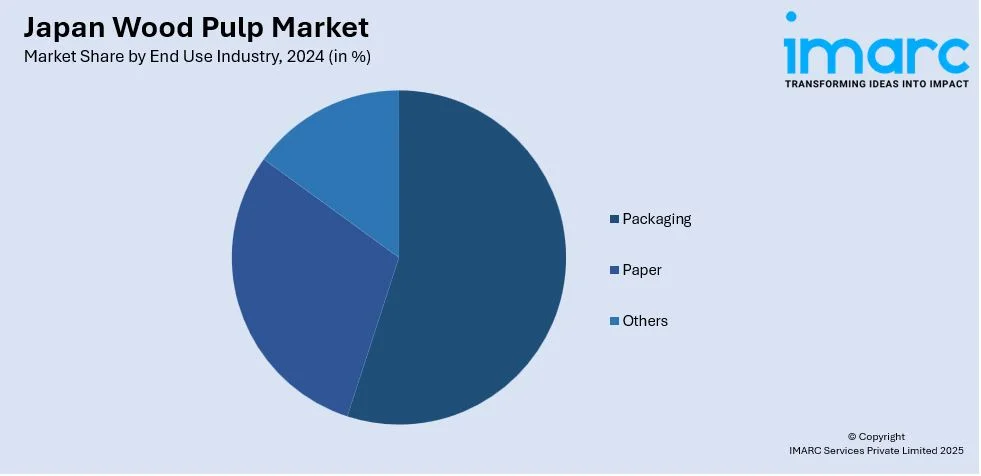
Japan Wood Pulp Market Size, Share, Trends and Forecast by Type, Grade, End Use Industry, and Region, 2025-2033
Japan Wood Pulp Market Overview:
The Japan wood pulp market size reached USD 10.3 Billion in 2024. Looking forward, IMARC Group expects the market to reach USD 13.1 Billion by 2033, exhibiting a growth rate (CAGR) of 2.73% during 2025-2033. The rising demand for sustainable packaging, increasing tissue paper consumption, growing adoption of paper-based products across commercial sectors, technological advancements in pulping processes, and government support for eco-friendly materials are some of the factors facilitating the market growth.
|
Report Attribute
|
Key Statistics
|
|---|---|
|
Base Year
|
2024 |
|
Forecast Years
|
2025-2033
|
|
Historical Years
|
2019-2024
|
| Market Size in 2024 | USD 10.3 Billion |
| Market Forecast in 2033 | USD 13.1 Billion |
| Market Growth Rate 2025-2033 | 2.73% |
Japan Wood Pulp Market Trends:
Rising Demand for Sustainable Packaging Materials
The shift toward sustainable packaging solutions is positively impacting the Japan wood pulp market outlook. Additionally, growing environmental concerns and regulatory restrictions on single-use plastics are accelerating the adoption of paper-based alternatives, positioning wood pulp as a critical raw material. For instance, the Japanese government’s policy framework targeting a 25% reduction in single-use plastic generation and a 60% recycling rate by 2030 underscores the country’s commitment to sustainable material use. These initiatives are directly influencing the market, driving demand for pulp-based materials across retail, food service, and FMCG sectors. Companies in urban centers are increasingly integrating biodegradable and recyclable packaging formats into their operations to align with environmental goals and consumer expectations. As a result, demand for virgin and recycled pulp suitable for flexible packaging, molded fiber products, and paperboard is growing significantly. Domestic paper producers are expanding their capacity and investing in advanced pulping technology to meet these evolving material requirements. Besides this, international players are making partnerships or acquisitions to enter the premium-grade sustainable pulp segment in Japan. These developments reflect a broader, long-term structural change in Japan’s packaging sector, where wood pulp’s renewable nature is central to compliance, branding, and consumer expectations.

Growth in Hygiene Product Consumption
Japan’s aging population and rising health awareness are key drivers increasing the consumption of hygiene products, which, in turn, is driving the Japan wood pulp market growth. According to industry reports, as of September 2023, the number of older adults in Japan rose by 20,000 to reach 36.25 Million, representing a record 29.3% of the total population. This demographic shift is significantly expanding the market for adult incontinence products, a major end-use category for pulp-based hygiene materials. Products such as adult diapers, sanitary napkins, baby diapers, and facial tissues require high-absorbency pulp, including fluff and bleached kraft pulp. Japan has one of the highest per capita usages of adult incontinence products globally, and this segment continues to grow with the country’s demographic shift. Furthermore, domestic pulp manufacturers are optimizing their product mix toward hygiene-grade pulp and upgrading mill capabilities to ensure product consistency, softness, and fluid retention. Also, foreign pulp suppliers are strengthening trade relationships with Japanese converters and hygiene brands, supplying premium-quality fluff pulp. Sustainability criteria in hygiene products have also emerged, with increasing demand for Forest Stewardship Council (FSC)-certified or PEFC-certified pulp sources. These factors are significantly expanding the Japan wood pulp market share.
Japan Wood Pulp Market Segmentation:
IMARC Group provides an analysis of the key trends in each segment of the market, along with forecasts at the country level for 2025-2033. Our report has categorized the market based on type, grade, and end use industry.
Type Insights:
- Hardwood
- Softwood
The report has provided a detailed breakup and analysis of the market based on the type. This includes hardwood and softwood.
Grade Insights:
- Mechanical
- Chemical
- Semi-Chemical
- Others
A detailed breakup and analysis of the market based on the grade have also been provided in the report. This includes mechanical, chemical, semi-chemical, and others.
End Use Industry Insights:

- Packaging
- Food and Beverages
- Pharmaceutical
- Personal Care and Cosmetics
- Automotive
- Others
- Paper
- Newspaper
- Books and Magazines
- Tissues
- Others
- Others
The report has provided a detailed breakup and analysis of the market based on the end use industry. This includes packaging (food and beverages, pharmaceutical, personal care and cosmetics, automotive, and others), paper (newspaper, books and magazines, tissues, and others), and others.
Regional Insights:
- Kanto Region
- Kansai/Kinki Region
- Central/Chubu Region
- Kyushu-Okinawa Region
- Tohoku Region
- Chugoku Region
- Hokkaido Region
- Shikoku Region
The report has also provided a comprehensive analysis of all the major regional markets, which include Kanto Region, Kansai/Kinki Region, Central /Chubu Region, Kyushu-Okinawa Region, Tohoku Region, Chugoku Region, Hokkaido Region, and Shikoku Region.
Competitive Landscape:
The market research report has also provided a comprehensive analysis of the competitive landscape. Competitive analysis such as market structure, key player positioning, top winning strategies, competitive dashboard, and company evaluation quadrant has been covered in the report. Also, detailed profiles of all major companies have been provided.
Japan Wood Pulp Market News:
- November 2024: Mitsubishi Heavy Industries and Hokuetsu Corporation launched a CO2 capture demonstration test at Hokuetsu's Niigata Mill in Japan to decarbonize the pulp and paper industry. The test uses MHI’s CO2MPACT™ Mobile system to capture CO2 from chemical recovery boilers fueled by black liquor, a by-product of pulp production. This pioneering project marks the first application of CO2 capture technology in the pulp and paper sector, supporting sustainability efforts in the industry.
Japan Wood Pulp Market Report Coverage:
| Report Features | Details |
|---|---|
| Base Year of the Analysis | 2024 |
| Historical Period | 2019-2024 |
| Forecast Period | 2025-2033 |
| Units | Billion USD |
| Scope of the Report |
Exploration of Historical Trends and Market Outlook, Industry Catalysts and Challenges, Segment-Wise Historical and Future Market Assessment:
|
| Types Covered | Hardwood, Softwood |
| Grades Covered | Mechanical, Chemical, Semi-Chemical, Others |
| End Use Industries Covered |
|
| Regions Covered | Kanto Region, Kansai/Kinki Region, Central/Chubu Region, Kyushu-Okinawa Region, Tohoku Region, Chugoku Region, Hokkaido Region, Shikoku Region |
| Customization Scope | 10% Free Customization |
| Post-Sale Analyst Support | 10-12 Weeks |
| Delivery Format | PDF and Excel through Email (We can also provide the editable version of the report in PPT/Word format on special request) |
Key Questions Answered in This Report:
- How has the Japan wood pulp market performed so far and how will it perform in the coming years?
- What is the breakup of the Japan wood pulp market on the basis of type?
- What is the breakup of the Japan wood pulp market on the basis of grade?
- What is the breakup of the Japan wood pulp market on the basis of end use industry?
- What is the breakup of the Japan wood pulp market on the basis of region?
- What are the various stages in the value chain of the Japan wood pulp market?
- What are the key driving factors and challenges in the Japan wood pulp market?
- What is the structure of the Japan wood pulp market and who are the key players?
- What is the degree of competition in the Japan wood pulp market?
Key Benefits for Stakeholders:
- IMARC’s industry report offers a comprehensive quantitative analysis of various market segments, historical and current market trends, market forecasts, and dynamics of the Japan wood pulp market from 2019-2033.
- The research report provides the latest information on the market drivers, challenges, and opportunities in the Japan wood pulp market.
- Porter's five forces analysis assist stakeholders in assessing the impact of new entrants, competitive rivalry, supplier power, buyer power, and the threat of substitution. It helps stakeholders to analyze the level of competition within the Japan wood pulp industry and its attractiveness.
- Competitive landscape allows stakeholders to understand their competitive environment and provides an insight into the current positions of key players in the market.
Need more help?
- Speak to our experienced analysts for insights on the current market scenarios.
- Include additional segments and countries to customize the report as per your requirement.
- Gain an unparalleled competitive advantage in your domain by understanding how to utilize the report and positively impacting your operations and revenue.
- For further assistance, please connect with our analysts.
 Request Customization
Request Customization
 Speak to an Analyst
Speak to an Analyst
 Request Brochure
Request Brochure
 Inquire Before Buying
Inquire Before Buying




.webp)




.webp)












